GL Enhances T1 E1 Analyzer Products and Software Ver 5.13
Welcome to GL's Newsletter covering the latest products, features, and enhancements to our versatile T1 E1 Analyzer product line (Ver 5.13).
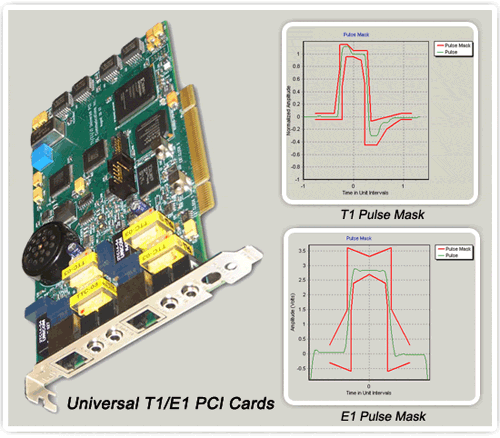
New Hardware
- Universal T1 E1 PCI Cards:
GL has added to its T1 E1 Analyzer hardware test suite new hardware called "Universal T1 E1 Analyzer". These cards easily plug into PCI 2.1 Compliant slots of any Pentium PC. The advantage it offers over the prior version of HD PCI T1 E1 cards is that it includes integrated hardware support for both T1 as well as E1 lines, thus allowing easy switching between T1 and E1 interface testing.
Universal T1 E1 Boards vs. Older HD T1 E1 Boards:
- Universal Boards are capable of T1 and E1 interfacing. Only software and drivers differentiate whether T1 or E1 signals are being processed. In the earlier versions, T1 was a different board than the E1
- Universal boards can be plugged into either a 5 V or 3.3 V PCI bus, i.e. (PCI 2.1 Compliant). Earlier T1 boards and E1 boards could only be plugged into a 5 V bus
- Universal boards have adjustable transmit clock frequency for testing frequency lock sensitivity of T1 or E1 equipment. The transmit clock can be adjusted + / - 300 PPM
- Two new port modes have been added: cross-port loopback and thru mode
- Cross-Port Loopback
This mode is similar to the standard "Outward Loopback" except that the signal received on Card 1 (Port 1) can be transmitted out onto Card 2 (Port 2). Likewise the signal received on Card 2 (Port 2) can be transmitted out onto Card 1 (Port 1). The hardware defaults to this mode (cross-port loopback) whenever the board is powered up or down. This feature allows you to monitor T1 / E1 lines "in-line" while still being protected from loss of power to the board.
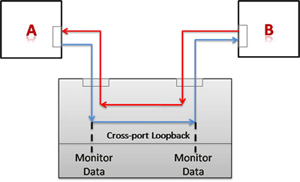
- Thru Mode
When Thru Mode is selected, the data that would normally be transmitted on Card 1 (Port 1) is diverted to transmit on Card 2 (Port 2) and the data that would normally be transmitted on Card 2 (Port 2) is diverted to transmit on Card 1 (Port 1). The receive paths are completely unaffected. This mode is particularly useful for Drop and Insert applications in which the board analyzes and may insert traffic running between two pieces of T1/E1 equipment. This feature eliminates complex cabling.
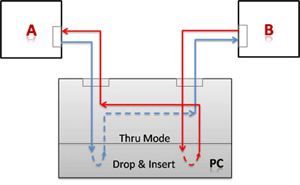
- Pulse Mask Display:
Incoming pulses are tested for compliance against T1 or E1 standard pulse mask specified by the ITU G.703 standard and ANSI T1.102-1993. This feature is also available with the Client Server software for automation and remoting applications.
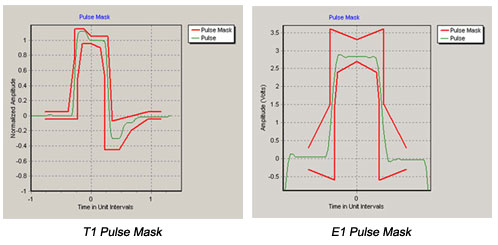
- Jitter Measurement and Generation (coming soon):
Jitter can be measured in the incoming T1 E1 signal. Jitter can also be introduced onto the outgoing T1 E1 signal. Software for this application will be available soon.
For comprehensive information on the product, please refer to Universal T1 E1 Cards website.
New Software:
- WCS ISDN Emulator:
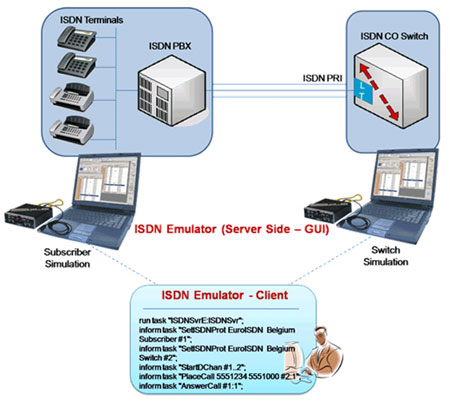
This Client-Server application is used for performing complete ISDN switch and subscriber emulation. The functions that can be performed using client-server are:
- Configuring the ISDN layer parameters, called/calling numbering plan/type, type of ISDN service
- Placing and accepting calls for each timeslot or for the whole trunk
- Loging call records for complete or incomplete calls
- Simple NFAS setup for T1
For comprehensive understanding of the enhancements introduced to the product, please visit the ISDN Emulator webpage.
- WCS Pulse Mask:
This Client-Server application in Universal boards is used for detection, monitoring, and plotting of transmitted pulses. It includes Monitor Pulse Mask and Pulse Mask Display modules that can be remotely controlled using simple commands by client applications. Some of the commands supported are CheckPulseMask, validate pulse, stop pulse mask validation, and others.
For comprehensive understanding of the product, please visit the WCS Pulse Mask webpage.
Other Enhancements:
There are significant enhancement introduced to the following applications:
If you have our products or are interested in these features, please download or enquire about these enhancements.
- Protocol Analyzers:
- ATM Analyzer - Real-time Capture Filter in ATM Analyzer now supports filtering of Idle Cells along with the specified VPI, VCI, and PT values
- Segmentation and Reassembly feature in ATM Analyzer now supports AAL - Layer 0
- MLPPP analyzer is also enhanced to decode padded NCP messages
- UMTS Protocol Analyzer- The UMTS protocol analysis is now supported over IP as well as over T1 E1 and
ATM. The supported standards include ATM, ATM AAL2 & AAL5, SSCOP, IP, UDP, SCTP, SSCF-UNI, SSCF-NNI, SAAL-NNI,
NBAP, ALCAP, Iub-FP, Iu-UP, UMAC, RLC, MTP3B, SCCP, RANAP, M3UA, CC, MM, SMS, SM, SSSAR, and RNSAP.
For comprehensive understanding of the enhancements introduced to the protocol product series, please visit Protocol Analyzers web page
- TRAU ToolBox™ and Analysis
- Supports AMR -WB codec with data rates of 6.60 kbps, 8.85 kbps, 12.65kbps
- Number of active streams for compression or decompression for HR codecs was limited to one stream in earlier versions. In T1E1 analyzer ver5.13, we can have multiple streams for HR
- AMR and HR is implemented using Voice Age codec library
For comprehensive understanding of the enhancements introduced to the Trau protocol product series, please visit TRAU ToolBox™ and Analysis web page
- Multi-Class ML-PPP Emulator
- The Command Line Interface of MC-MLPPP Emulator has been updated and made backward compatible for the scripts in earlier version of T1/E1 analyzer
- Minimum value of Payload length & Fragment length is reduced to 1, i.e. PL ranges from 1 to 10,000, and FL ranges
from 1 to 1500. Maximum Hex String Length is now increased to 600 bytes.
For comprehensive understanding of the enhancements introduced to the MC ML-PPP protocol product series, please visit Multi-Class ML-PPP Emulator web page
- Windows Client-Server
- The "tx server file" command in Error Insertion module of WCS has been modified to transmit data on multiple cards which has improved the performance of the tester
For comprehensive understanding of the enhancements introduced to the protocol product series, please visit Windows Client-Server web page
In addition to the above, there have been many minor modifications and bug fixes to the T1E1 Software.
For more details, please refer to the link What's new in the current version web page
 Back to Latest News Page
Back to Latest News Page